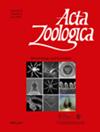Development, differentiation and toughness in lizard claws derive from two types of cysteine–glycine‐rich proteins
IF 1.1
4区 生物学
Q4 ANATOMY & MORPHOLOGY
引用次数: 0
Abstract
The present study reports the formation of claws in lizards and their cornification. From a flat epidermis with lose mesenchyme, the skin forms undulations that become symmetric domes and later asymmetric for the elongation of their proximal part that gives rise to the outer scale surface. At the tip of digits claws develop in association with a mesenchyme that surrounds the cartilage of the last phalange. Beta‐cells of claws appear 2–3 embryonic stages before those of scales formed in other body regions, including digital scales. The epidermis of the developing claw initially forms 3–4 embryonic layers under which elongated beta‐cells accumulate long bundles of corneous material, immunopositive for CBPs. Claw beta‐keratinocytes incorporate tritiated proline and accumulate numerous, oriented corneous bundles that rapidly occupy the entire cell. The bundles are electron‐dense under transmission electron microscopy, suggesting that, in association to CBPs, other proteins are synthesized and increase the mechanical resistance of claws. Immunolabelling for cysteine‐rich IFKs, HA and HB, shows that these keratins co‐localize with CBPs only in claws but are low to absent in digital scales and adhesive setae. This indicates that the hardness of claws mainly depends from the association between these different proteins rich in glycine and cysteine.蜥蜴爪子的发育、分化和韧性源自两种富含半胱氨酸-甘氨酸的蛋白质
本研究报告了蜥蜴爪的形成及其角化过程。皮肤从失去间质的扁平表皮开始形成起伏,这些起伏成为对称的圆顶,后来由于近端部分的伸长而形成不对称的圆顶,进而形成外鳞片表面。在趾甲的顶端,趾爪与围绕最后一节趾骨软骨的间质一起发育。爪的 Beta 细胞比其他身体区域(包括数字鳞片)形成的鳞片的 Beta 细胞早 2-3 个胚胎阶段出现。发育中的爪表皮最初会形成 3-4 个胚层,在这些胚层下,拉长的 beta 细胞会积聚长长的角质材料束,CBPs 免疫呈阳性。爪β角质细胞结合三尖脯氨酸,并积累大量定向角质束,这些角质束迅速占据整个细胞。在透射电子显微镜下,角质束呈电子致密状,这表明除了 CBPs 外,还合成了其他蛋白质,从而增强了爪的机械阻力。对富含半胱氨酸的 IFKs、HA 和 HB 的免疫标记表明,这些角蛋白只在爪中与 CBPs 共定位,而在数字鳞片和粘着刚毛中则很少或没有。这表明,爪的硬度主要取决于这些富含甘氨酸和半胱氨酸的不同蛋白质之间的关联。
本文章由计算机程序翻译,如有差异,请以英文原文为准。
求助全文
约1分钟内获得全文
求助全文
来源期刊

Acta Zoologica
生物-动物学
CiteScore
2.90
自引率
8.30%
发文量
35
审稿时长
>12 weeks
期刊介绍:
Published regularly since 1920, Acta Zoologica has retained its position as one of the world''s leading journals in the field of animal organization, development, structure and function. Each issue publishes original research of interest to zoologists and physiologists worldwide, in the field of animal structure (from the cellular to the organismic level) and development with emphasis on functional, comparative and phylogenetic aspects. Occasional review articles are also published, as well as book reviews.
 求助内容:
求助内容: 应助结果提醒方式:
应助结果提醒方式:


